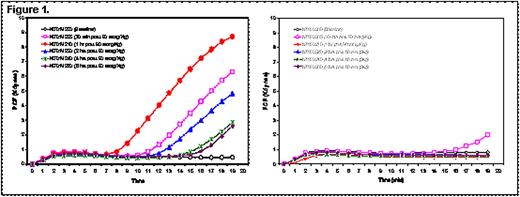Abstract
Abstract 4440
It is known that some FVIII deficient patients who develop high titer FVIII inhibitors do not respond as expected to inhibitor bypassing agents. During an IRB approved study of laboratory monitoring of rFVIIa infusion in hemophilia patients, we had the opportunity to extensively study a patient who was known to respond poorly to standard dose (90 mg/kg) rFVIIa. We present here results from this patient included in this study and question whether it might be possible to predict poor response from in vitro measurements.
The patient is a 43 year old male with severe hemophilia A (FVIII<1%) and a high titer FVIII antibody (10.4 BU). In 2003, attempts were made to treat spontaneous joint bleeds with standard (90 mg/kg) dose rFVIIa. Responses were poor and the patient was switched to FEIBA (>6000 IU per infusion) to which he responded. He continues to bleed frequently with 7 documented bleeds requiring 21 infusions of FEIBA for treatment during the first six months of 2009.
This patient was one of 10 hemophiliacs participating in a clinical study of rFVIIa. Blood samples were drawn at baseline and at 0.5, 1, 2, 4 and 6 hours after a single dose of rFVIIa 90 mg/kg. Parameters measured included PT, PTT, fibrinogen level and whole blood assays (Hemodyne HAS, TEG®, and ROTEG®). Thrombin generation was measured in PPP and PRP by CAT. Plasma samples were analyzed for Prothrombin Fragment 1.2, FVII:C, FVII:Ag, FVIIa:ATIII and D-dimer. In addition, in this patient an in vitro spiking study of rFVIIa corresponding to doses of 90, 180 and 270 mg/kg was performed to determine the clotting parameters.
At baseline, his PT was 9.6 seconds, PTT was 112 seconds, and fibrinogen was 238 mg/dl. Samples for TEG, HAS and ROTEG analysis all failed to clot when re-calcified and monitored for up to 60 minutes. Thirty minutes post infusion of rFVIIa, HAS parameters slightly improved (FOT=16 min, PCF 2.0 Kdyn) but quickly reverted to grossly abnormal at one hour. This is in marked contrast to the typical response of most patients in the study as demonstrated in (Fig.1).
The R for TEG shortened to 14.4 min and CT for ROTEM decreased to 1094 sec after 30 minutes and remained measurable but grossly abnormal (30 min and 2000 sec) for the next six hours. MA (60 mm) and MCF (60 mm) normalized at 30 min and remained normal for the next six hours. Results of CAT were dependent on the sample type and clot triggering agent. Re-calcification in PRP resulted in shortening of T-lag to 21.5 minutes and a C-max of 15.8 nM both of which were grossly abnormal. T-lag for PRP clotted with 1pm TF was 9.9 min and shortened to 5 min post rFVIIa infusion. ETP when measurable was very low. For PPP clotted with 0.5 pM TF and 4mM phospholipid, the T-lag decreased from a baseline of 5 to <3 min post rFVIIa infusion and remained <3 for six hours. Baseline antigen and coagulant rFVIIa, D-Dimer and F1+2 levels were normal in the patient and the pattern of response did not differ from those seen with patients who had normal responses to rFVIIa. The pharmacokinetics of rFVIIa in this patient were determined, and were consistent with other study participants (Cltot: 66.3, mean= 50.8 ml/hr*kg).
During the in vitro experiment, addition of rFVII produced HAS results equivalent to those seen 30 minutes after rFVIIa infusion (Table). Addition of concentrations equivalent to 180 and 270 mg/Kg doses produced additional correction.
| . | PCF (Kdyn) . | CEM (Kdyn/cm2) . | FOT (min) . |
|---|---|---|---|
| In-vitro rFVIIa Spiking Study | |||
| Baseline | 0.26 | 0.0 | >20.0 |
| 90 μg/Kg | 1.52 | 6.6 | 16.0 |
| 180 μg/Kg | 5.01 | 22.5 | 11.5 |
| 270 μg/Kg | 7.72 | 30.6 | 7.0 |
| In-vivo rFVIIa Infusion Study | |||
| Baseline | 0.20 | 0.0 | >20.0 |
| 30 min post 90 μg/Kg | 2.01 | 5.5 | 16.0 |
| . | PCF (Kdyn) . | CEM (Kdyn/cm2) . | FOT (min) . |
|---|---|---|---|
| In-vitro rFVIIa Spiking Study | |||
| Baseline | 0.26 | 0.0 | >20.0 |
| 90 μg/Kg | 1.52 | 6.6 | 16.0 |
| 180 μg/Kg | 5.01 | 22.5 | 11.5 |
| 270 μg/Kg | 7.72 | 30.6 | 7.0 |
| In-vivo rFVIIa Infusion Study | |||
| Baseline | 0.20 | 0.0 | >20.0 |
| 30 min post 90 μg/Kg | 2.01 | 5.5 | 16.0 |
Normal Ranges: PCF (4.8-9.5 Kdyn); CEM (14.0-35.0 kdyn/cm2); FOT (3.0-8.0 min)
We have analyzed the response to rFVIIa infusion using multiple clotting parameters in a patient with known poor clinical response to standard dose rFVIIa. The clotting lag times of whole blood assays including the HAS, TEG and ROTEG appear to be sensitive to varying degrees to the decreased response to rFVIIa. Thrombin generation was grossly abnormal in PRP but appeared relatively insensitive in PPP to the decreased rFVIIa effect. Spiking studies in the HAS correlated with results from infusion and also indicated that the patient might respond to higher dose rFVIIa. This possibility has not been clinically confirmed, but these results raise the possibility of identifying poor responders and perhaps helping to predict doses that might be effective.
Ezban:NovoNordisk A/S: Employment. Hedner:NovoNordisk: Employment.
Author notes
Asterisk with author names denotes non-ASH members.


